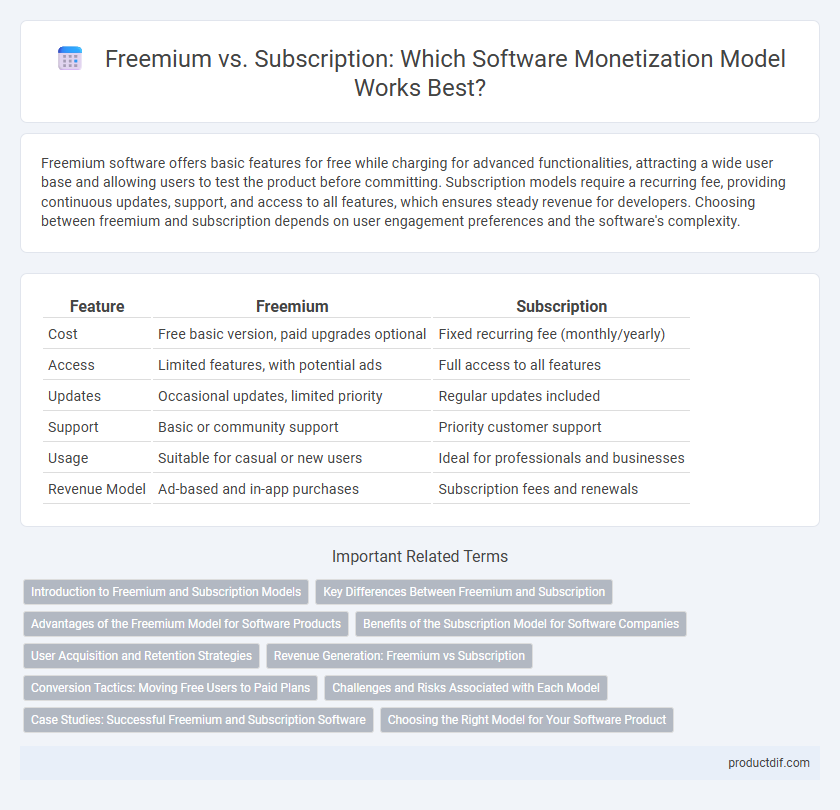Freemium software offers basic features for free while charging for advanced functionalities, attracting a wide user base and allowing users to test the product before committing. Subscription models require a recurring fee, providing continuous updates, support, and access to all features, which ensures steady revenue for developers. Choosing between freemium and subscription depends on user engagement preferences and the software's complexity.
Table of Comparison
| Feature | Freemium | Subscription |
|---|---|---|
| Cost | Free basic version, paid upgrades optional | Fixed recurring fee (monthly/yearly) |
| Access | Limited features, with potential ads | Full access to all features |
| Updates | Occasional updates, limited priority | Regular updates included |
| Support | Basic or community support | Priority customer support |
| Usage | Suitable for casual or new users | Ideal for professionals and businesses |
| Revenue Model | Ad-based and in-app purchases | Subscription fees and renewals |
Introduction to Freemium and Subscription Models
Freemium software offers basic features at no cost while charging for premium capabilities, enabling users to try the product before committing financially. Subscription models require regular payments, typically monthly or yearly, granting continuous access to software updates and customer support. Both models cater to different user preferences, balancing user acquisition and steady revenue streams in the software industry.
Key Differences Between Freemium and Subscription
Freemium software offers core features at no cost with optional paid upgrades, while subscription models require regular payments for full access and continuous service. Freemium targets user acquisition and gradual monetization, whereas subscriptions emphasize steady revenue and customer retention. Key differences include payment structure, feature access, and user commitment duration.
Advantages of the Freemium Model for Software Products
The freemium model offers software products widespread user acquisition by allowing free access to core features, reducing entry barriers and increasing brand visibility. It encourages user engagement and feedback, enabling continuous product improvement tailored to customer needs. This model also creates multiple upsell opportunities by converting free users into paid subscribers through premium features and enhanced services.
Benefits of the Subscription Model for Software Companies
The subscription model offers software companies a predictable and recurring revenue stream, enhancing financial stability and enabling better resource planning. This model fosters stronger customer relationships through continuous engagement and regular updates, increasing user retention and lifetime value. Subscription services also facilitate scalability, allowing companies to deploy new features and scale offerings based on user demand efficiently.
User Acquisition and Retention Strategies
Freemium models attract a larger initial user base by offering free access to basic features, encouraging widespread adoption and organic growth through word-of-mouth. Subscription models generate consistent revenue and enhance user retention by providing premium features, regular updates, and exclusive content that increase perceived value. Combining freemium acquisition with subscription-based retention strategies optimizes lifetime customer value and minimizes churn rates.
Revenue Generation: Freemium vs Subscription
Freemium models generate revenue primarily through a limited free tier that attracts a large user base and upsells premium features, driving conversions over time. Subscription models deliver predictable, recurring revenue by charging users fixed fees at regular intervals, enhancing financial stability and cash flow forecasting. Companies often balance freemium's user acquisition strength with subscription's consistent income to optimize overall revenue generation.
Conversion Tactics: Moving Free Users to Paid Plans
Effective conversion tactics from freemium to subscription include offering limited-time discounts and exclusive feature access to incentivize upgrades. Data-driven targeting based on user behavior, such as frequency of use and feature engagement, increases conversion rates by presenting personalized upgrade prompts. Clear value communication through in-app messaging and email campaigns highlights the tangible benefits of paid plans, fostering user motivation to switch.
Challenges and Risks Associated with Each Model
Freemium models often face challenges in converting free users to paying customers, leading to high acquisition costs and limited revenue generation. Subscription models carry risks like customer churn and the need for continuous value delivery to justify recurring fees. Both approaches require strategic management of customer engagement and monetization to achieve sustainable growth.
Case Studies: Successful Freemium and Subscription Software
Slack's freemium model attracted millions by offering essential collaboration tools for free, which successfully converted a large user base into paying customers through premium features. Adobe Creative Cloud's subscription model generated steady revenue by providing continuous updates and a comprehensive suite of design software, enhancing customer retention and satisfaction. Case studies from companies like Spotify demonstrate how combining freemium access with subscription tiers maximizes both user acquisition and long-term profitability.
Choosing the Right Model for Your Software Product
Selecting the ideal pricing model for your software product hinges on aligning with target user behavior and revenue goals; freemium offers basic features for free, enticing users to upgrade, while subscription delivers consistent recurring revenue through full access at a recurring fee. Analyze market demand, customer willingness to pay, and competitor strategies to determine if offering a free tier with premium upgrades or enforcing a subscription-only approach better supports growth and monetization. Prioritize scalability, ongoing user engagement, and lifetime value metrics to ensure the chosen model maximizes profitability and user retention over time.
Freemium vs Subscription Infographic

 productdif.com
productdif.com